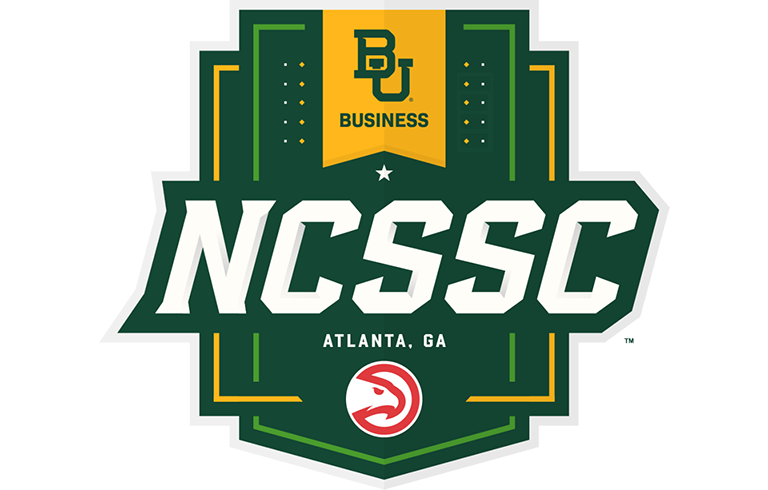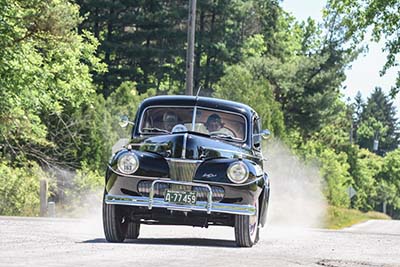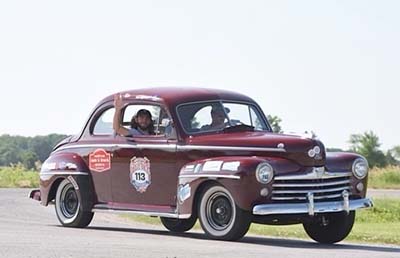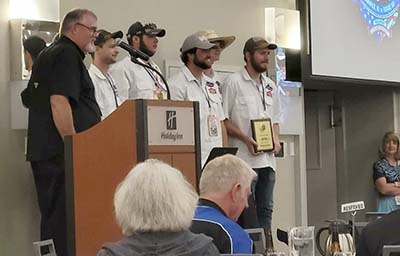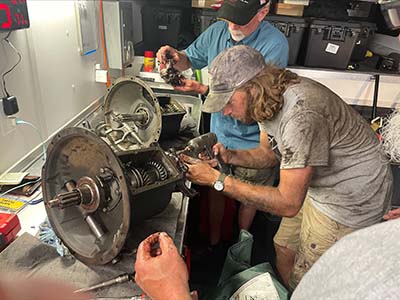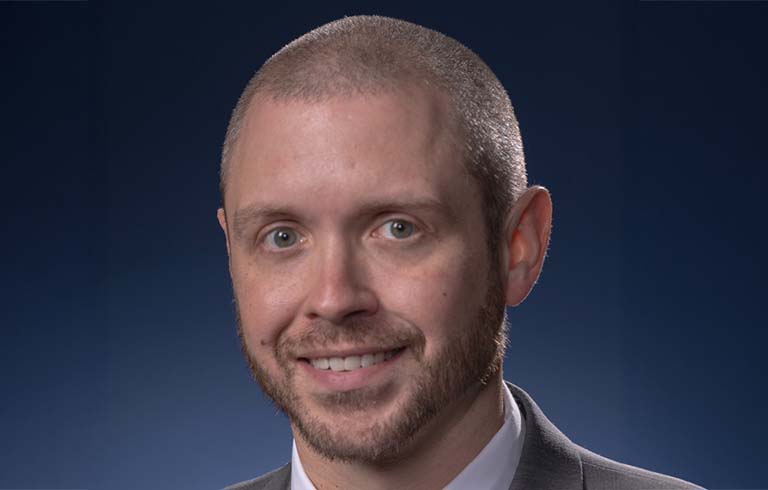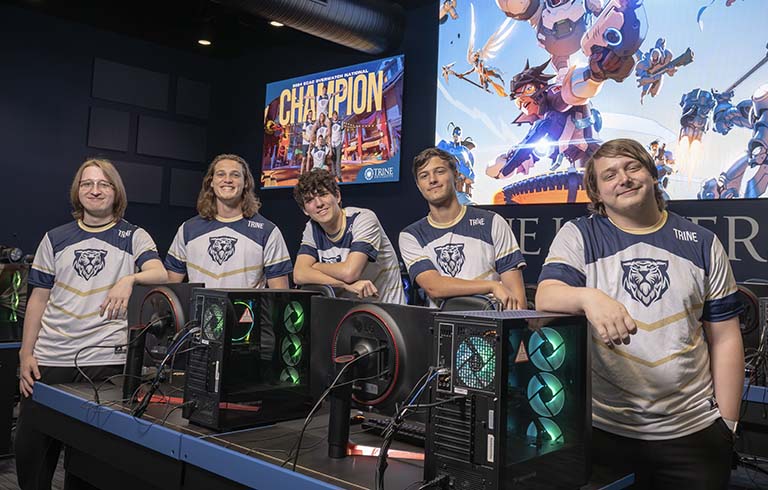Driving and servicing cars built more than half a century before they were born, two
Trine University students were part of teams that competed in the Hemmings Motor News Great Race.
The race, held June 18-26, featured 130 vintage cars that traveled from Warwick, Rhode
Island, to Fargo, North Dakota.
Gavin Swift, an accounting major from Auburn, Indiana, and Connor Miller, a design
engineering technology major from Warren, Indiana, competed on teams sponsored by
the National Auto and Truck Museum (NATMUS) and the Early Ford V-8 Museum, both in Auburn.
Swift was part of a team that operated a 1941 Ford Super Deluxe Sedan, while Miller’s
team got a 1948 Ford 2 Door Business Coupe to Fargo.
A need for youth
Swift and Miller are both part of a youth volunteer program at NATMUS that helps maintain
and repair the museum’s vehicles. During a cruise-in where both museums were participating,
the NATMUS volunteers saw cars the Early Ford V-8 Museum had entered in a prior Great
Race.
“They wanted to race again but couldn't find youth who wanted to race,” Swift said.
“From there, the two museums teamed up because NATMUS had the youth members to drive,
while the Ford Museum had the vehicles to race in.”
Swift jumped at the opportunity to represent his hometown and its automobile history,
and both students looked forward to the adventure of driving classic cars cross-country.
“I knew it would be the experience of a lifetime,” Miller said.
The two were part of a team of six that worked for a year to get the cars in race
condition. For example, though the 1948 Coupe was drivable when they got it, Miller
said the group replaced the transmission, torque tube, rear axle, various engine parts
and the gas tank and sending unit; upgraded it to disc brakes and replaced the brake
lines; rebuilt the suspension; and rewired the gauges.
Not to the swift
Held annually since 1983, the Great Race is not a race in the sense that the fastest
time wins. Instead, teams must follow a detailed course, much of it through scenic
local and state highways, and arrive at checkpoints as close as possible to the exact
time specified.
Teams are given the course, which typically includes more than 200 instructions, at
the beginning of each day. The race tests the ability of drivers and navigators to
follow instructions, and the endurance of the vehicles.
Though the teams rotated roles, Miller and Swift primarily served as navigators for
their cars.
“It was my duty to tell the driver directions while simultaneously making calculations
to try and get to our checkpoints right on time; not too early, not too late,” Swift
said.
“When I got to the race I started learning about everything that went into navigating.
I got addicted when one of the older racers started explaining the different methods
of navigating,” Miller said.
Though technically competitors, Swift said the teams helped each other out throughout
the race.
“We all were racing as one big team from Auburn, in two different vehicles,” Swift
said.
Broken gears, vapor lock
The 1948 Coupe was rebuilt but untested, which caused multiple issues once the team
arrived in Warwick for pre-race events.
“We didn’t even make it out of the parking lot before the transmission broke,” Miller
said. “We had to have a transmission from a fellow competitor brought in and we replaced
it in four hours.”
In addition to making repairs, Miller said his group volunteered to run the tech inspection,
conducted a promotional interview on television, took part in a day of rallying and
“got to tour four very impressive garages.”
“This all was very exciting and was slightly overwhelming. That’s a lot to do in three
days,” he said.
Once the race began, the team encountered ignition and vapor lock issues, had to hot
wire a broken fuel pump switch and had to replace the points (used in older cars to
power the spark plugs) in the parking lot of a waterpark resort at midnight.
“During this we also re-plumbed the fuel system because we were still fighting heat
issues, which was causing vapor lock,” Miller said. “We also ran into some issues
navigating because we were all new to this and had to figure out what we were doing.”
Lending a hand
Despite the mechanical issues, Miller’s team won an Ace, awarded for achieving the
perfect time for that leg of the race, on the first day.
“We ended up getting two aces over the nine days, but the first one felt good because
we had just changed the transmission two days before this and it seemed like a major
win,” he said.
Even the broken transmission came in handy. Miller’s team was able to use that transmission
to help another team, a 1931 Ford Model A that broke its third gear.
“Lucky for him it had the same transmission as the one we had blown two days earlier
in our 1948 Ford,” Miller said. “When we broke ours, we broke first gear. We took
first gear out of our transmission and put the first gear from his transmission in
ours.”
By the time Miller’s team and the mechanic from the other team installed the transmission
and related systems, it was 2:30 a.m. They rose at 7 to get brake fluid and Miller
and the Model A’s mechanic bled the brakes on that car.
The Model A ran the rest of the race without mechanical issues.
Diverse stories, scenery
Though Swift said the race was “fast-paced, intense and sometimes stressful,” he particularly
enjoyed bonding with teammates and meeting people from around the world who came to
compete.
“It was interesting to hear other people's stories behind their cars and their involvement
in the Great Race,” he said. “Each of the competitors treated each other like family.
It truly felt as if we were family first, competitors second.”
Since he had never been to the Northeast, he enjoyed seeing the natural beauty of
states like New York, Rhode Island and Connecticut, as well as views of Lake Superior
when the race continued through Minnesota and Wisconsin.
The race also passed through his home county, DeKalb County, when it went through
northeast Indiana.
“I was excited that the racers from all over the world were able to see my home,”
he said.
Finish line and beyond
The 1941 Sedan finished 62nd. Swift said his group was happy with being in the top half in their first year of
racing.
“Midway through the race, my team and I discovered a new navigating method that drastically
improved our score,” he said. “Next time we race, we can use this method for the entire
race.”
Miller took the wheel of the 1948 Coupe for the final day of racing. He said the team
discovered a blown head gasket that day, but was able to make it to the finish line,
finishing 89th.
“I feel very good about this because when we were having good days my driver and I
did very well,” he said. “Most of the time penalties we had came from our car breaking
down.”
Both plan to race next year if the museums field a team again. Miller said the group
has already started talking about how to prepare for the next race.
Swift said he would one day like to race his own classic car.
In the meantime, the 1941 Ford Super Deluxe Sedan and the 1948 Ford 2 Door Business
Coupe are getting a well-deserved rest on display at the National Auto and Truck Museum.
